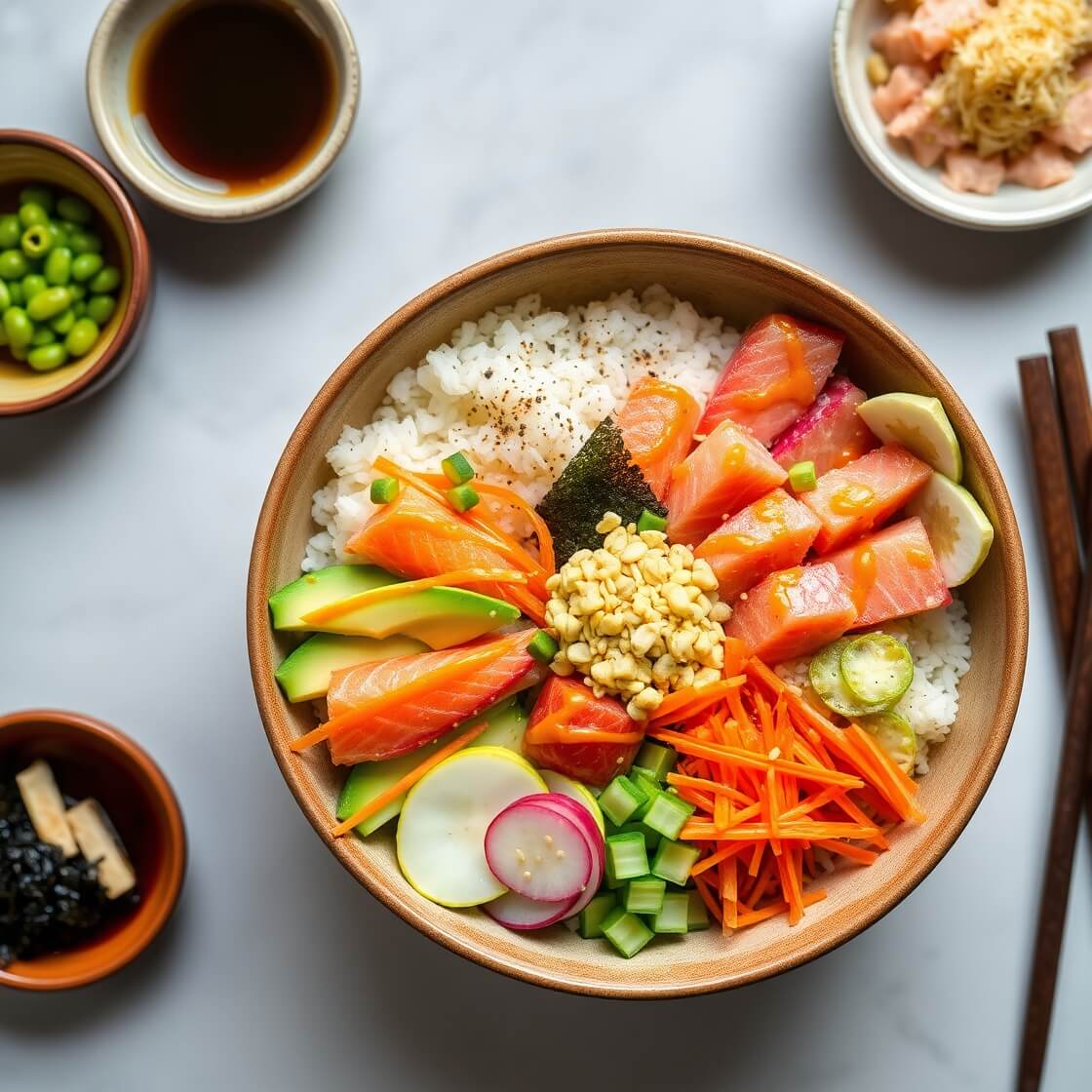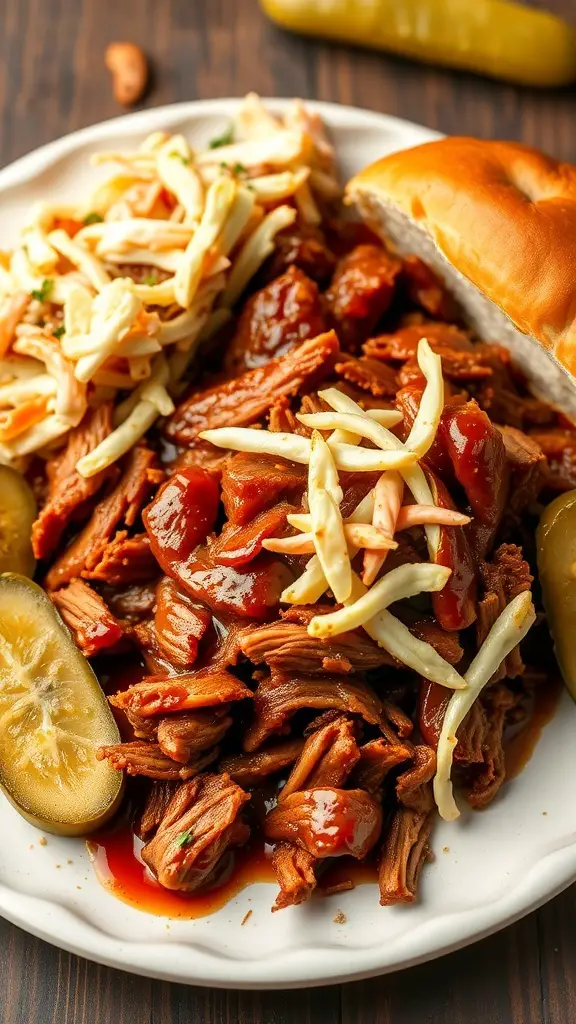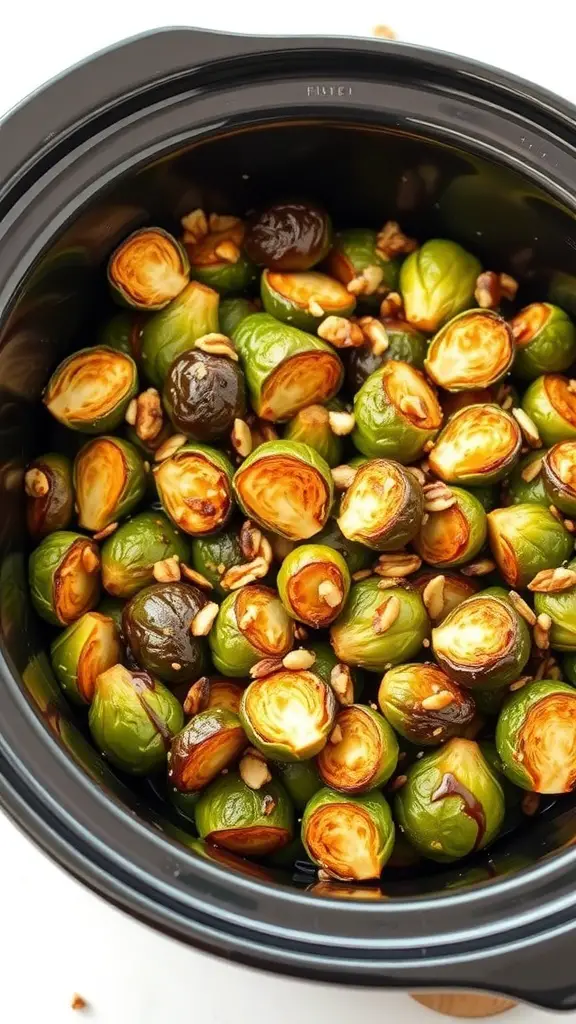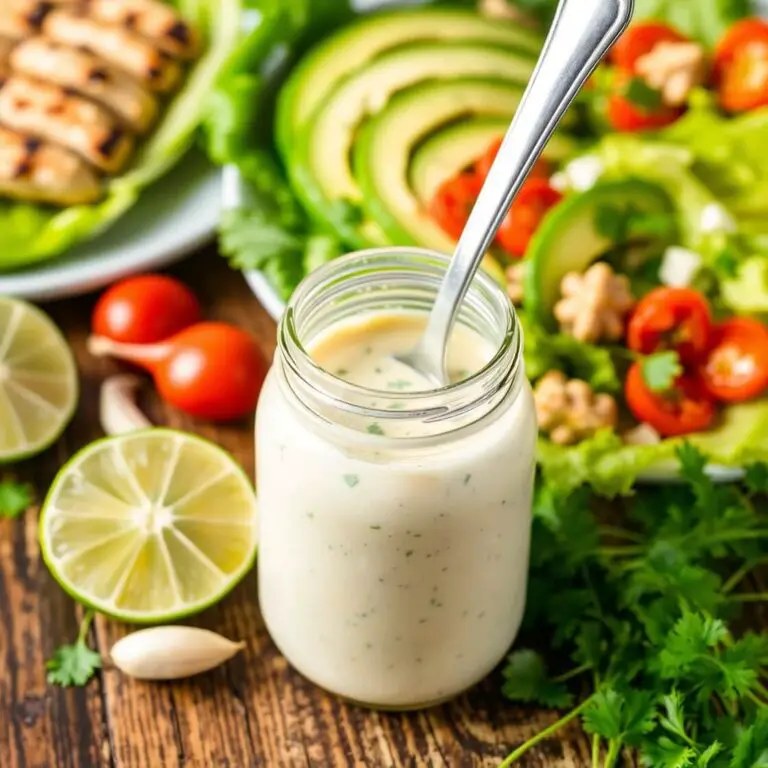
Sushi bowls are the perfect way to enjoy all the vibrant flavors and textures of traditional sushi without the fuss of rolling and shaping. I created this recipe for busy weeknights when I crave sushi but don’t have the time or patience for the full sushi-making process. Plus, it’s a fun and customizable dish that lets you pile on your favorite fresh ingredients in a bowl for a healthy, satisfying meal.
If you love sushi but want a quicker, easier, and equally delicious option, then a sushi bowl is exactly what you need. It’s fresh, flavorful, colorful, and comes together in no time. Whether you’re feeding yourself or impressing guests, this dish always delivers a wow factor.
Why I Love This Recipe
What makes this sushi bowl recipe truly special is its incredible simplicity combined with the authentic sushi experience. You get the same fresh, clean flavors and variety of textures found in a sushi roll but served as an accessible bowl. It’s approachable for home cooks of any skill level — no special rolling mats or techniques required.
It’s perfect for anyone who wants to enjoy sushi more often but feels intimidated by traditional sushi-making. The layering of vinegared rice, fresh fish or tofu, crunchy vegetables, creamy avocado, and a drizzle of soy sauce or spicy mayo brings an explosion of flavor and balance in every bite.
Plus, the sushi bowl is endlessly customizable. You can easily swap out ingredients to suit dietary needs, preferences, or what you have on hand. Whether you want it vegetarian, vegan, or packed with seafood, this recipe welcomes all variations.
The sushi bowl is also a nutritious powerhouse. You get lean protein, omega-3s, fiber from veggies, and healthy fats all in one bowl. And because it’s built on a base of seasoned sushi rice, it’s both comforting and refreshing.
Ingredients for Sushi Bowl
To make a sushi bowl that bursts with flavor and texture, you need a handful of key ingredients. The foundation is perfectly cooked sushi rice, seasoned with rice vinegar, sugar, and a touch of salt to give it that authentic sushi flavor.
For protein, I love using fresh sushi-grade salmon or tuna if I can get it, but cooked shrimp or tofu work wonderfully too for a milder or vegetarian option. The protein should be fresh, tender, and bite-sized.
Vegetables add crunch and freshness. Cucumber, shredded carrots, and thinly sliced radishes are classic choices. Edamame beans add a nice pop of color and a protein boost.
Creamy avocado slices bring richness that balances the rice’s acidity and the soy sauce’s saltiness. Pickled ginger adds a sharp, tangy contrast that cleanses the palate between bites.
Finally, no sushi bowl is complete without toppings like toasted sesame seeds, nori strips, and a drizzle of soy sauce or spicy mayo. Wasabi on the side is optional but adds a kick for those who love heat.
Here’s a quick rundown of the ingredients you’ll need:
- Sushi rice
- Rice vinegar, sugar, and salt (for seasoning rice)
- Fresh sushi-grade salmon, tuna, cooked shrimp, or tofu
- Cucumber
- Shredded carrots
- Radishes
- Edamame beans (shelled)
- Avocado
- Pickled ginger
- Toasted sesame seeds
- Nori sheets, cut into thin strips
- Soy sauce or tamari
- Optional: spicy mayo (mayonnaise mixed with sriracha), wasabi
How Much Time Will You Need
This sushi bowl recipe takes about 40 to 50 minutes total, including cooking and cooling the sushi rice. Preparing the rice is the most time-consuming step, as it needs to be cooked just right and then cooled to room temperature for the best texture.
Once the rice is ready, assembling the bowls is quick and fun — roughly 10 to 15 minutes depending on how many bowls you’re making. Preparing the fresh ingredients like slicing veggies and protein can be done while the rice cooks.
If you’re short on time, you can make the sushi rice in advance and keep it refrigerated. Just bring it back to room temperature before assembling your bowls for optimal flavor and texture.
How to Make This Sushi Bowl

Step – 1: Rinse the sushi rice under cold water until the water runs clear to remove excess starch.
Step – 2: Cook the sushi rice according to package instructions or in a rice cooker, using the appropriate water-to-rice ratio.
Step – 3: While the rice is cooking, prepare the sushi vinegar by mixing rice vinegar, sugar, and salt until dissolved.
Step – 4: Once the rice is cooked, transfer it to a large bowl and gently fold in the sushi vinegar mixture using a wooden spatula. Be careful not to mash the rice; use a slicing motion to evenly distribute the vinegar.
Step – 5: Spread the rice out to cool to room temperature, fanning it gently if possible to give it a shiny finish.
Step – 6: While the rice cools, prepare your protein and vegetables. Slice the fish or tofu into bite-sized pieces. Slice cucumber, radishes thinly, shred carrots, and shell edamame if needed.
Step – 7: Slice the avocado just before serving to prevent browning.
Step – 8: To assemble, spoon a generous portion of sushi rice into each bowl.
Step – 9: Arrange your protein, cucumber, carrots, radishes, edamame, and avocado artfully on top of the rice.
Step – 10: Garnish with pickled ginger, toasted sesame seeds, and nori strips.
Step – 11: Drizzle soy sauce or spicy mayo over the bowl, or serve on the side for dipping.
Step – 12: Add wasabi if desired, and enjoy immediately for the best flavor and texture.
Substitutions
One of the joys of the sushi bowl is how flexible it is with ingredients. If you can’t find sushi-grade fish, cooked shrimp or crab meat are fantastic alternatives that still bring a seafood flair.
For a vegetarian or vegan option, firm tofu works wonderfully. Press the tofu well and lightly pan-fry or marinate it for extra flavor. Tempeh is another protein-packed alternative.
If you prefer a gluten-free version, swap traditional soy sauce for tamari, which is naturally gluten-free. You can also use coconut aminos for a slightly sweeter, soy-free sauce.
In place of sushi rice, you could try brown rice or cauliflower rice for a lower-carb twist, though this changes the texture and flavor somewhat.
Feel free to add other veggies you love — sliced bell peppers, avocado chunks, or even mango for a sweet surprise. The key is balancing fresh, crunchy, creamy, and savory components.
Best Side Dish of Sushi Bowl
To round out your sushi bowl experience, here are three side dishes that pair beautifully:
- Miso soup: A warm, comforting classic that complements sushi flavors perfectly.
- Seaweed salad: Adds a tangy, umami-packed crunch that contrasts the soft rice and fish.
- Edamame pods: Lightly salted steamed edamame is a simple, protein-rich snack that’s fun to pop out of the pods.
These sides add variety and texture while keeping the meal light and balanced.
Serving and Presentation Tips
Presentation plays a huge role in elevating the sushi bowl from a simple meal to a show-stopping dish. One of the things I love most about sushi bowls is how vibrant and colorful they can look with just a few fresh ingredients.
To make your sushi bowl visually appealing, start by using a wide, shallow bowl. This gives you more space to spread out the ingredients, creating that layered look where everything is visible and easy to access. I like to place the rice as a base and then fan the toppings in sections — a scoop of edamame here, sliced avocado there, and thin ribbons of carrot or cucumber arranged like petals.
For protein like tuna or salmon, place the pieces front and center. A sprinkle of toasted sesame seeds, sliced green onions, or microgreens on top adds a pop of freshness. Lay down thin strips of nori or a few curls of pickled ginger at the edges to frame the bowl beautifully.
Finish with a drizzle of sauce just before serving. If you’re entertaining, you can even serve the sauce in tiny dipping dishes on the side for a more interactive experience. A small dollop of wasabi can sit at the edge of the bowl — it’s both flavorful and artistic.
Tips and Tricks to Make This Recipe More Better

What sets a great sushi bowl apart from a good one comes down to the details. Here are a few of my go-to tips that always elevate this dish:
- Use high-quality short-grain rice. It’s the foundation of your bowl, so don’t skimp. Rinse it thoroughly and don’t rush the cooling step — it helps the rice stay glossy and not mushy.
- Taste your sushi vinegar before mixing it into the rice. Every brand of rice vinegar is slightly different, so you might want to adjust the sugar or salt to get that perfect tangy-sweet balance.
- If you’re using raw fish, make sure it’s labeled “sushi-grade” from a reputable source. Keep it chilled until you’re ready to use it.
- Try marinating tofu or cooked shrimp in a bit of soy sauce, sesame oil, and garlic for added flavor before assembling.
- Prep all your veggies ahead of time. The more neatly and evenly they’re sliced, the more beautiful your final bowl will look.
- Don’t overdo the sauces. A light drizzle lets each ingredient shine without overpowering the dish.
Common Mistakes to Avoid
Sushi bowls are forgiving, but there are a few common mistakes that can trip you up:
- Using the wrong rice: Regular long-grain rice just doesn’t have the right stickiness or flavor. Stick with sushi rice or short-grain Japanese rice for the best results.
- Skipping the vinegar seasoning: This step is what gives sushi rice its signature flavor. Don’t forget it — plain rice will make the whole bowl taste bland.
- Overloading the bowl: It’s tempting to add everything, but too many toppings can overwhelm the balance. Stick to 4-6 well-paired toppings for the best harmony.
- Serving the rice too hot or too cold: Sushi rice should be slightly warm or at room temperature when served. Straight from the fridge or piping hot will throw off the texture and taste.
- Using low-quality fish: If you’re going for raw, quality is everything. Always buy from a trusted fishmonger and use it the same day.
How to Store It
Sushi bowls are best enjoyed fresh, but you can store the components separately if you’re planning ahead or have leftovers.
- Sushi rice: Store it in an airtight container at room temperature for up to 6 hours, or in the fridge for a day. Reheat gently in the microwave with a damp paper towel on top, or bring to room temp before serving.
- Veggies and toppings: Keep chopped vegetables and cooked proteins in separate airtight containers in the fridge for up to 2 days.
- Raw fish: Eat the same day if possible. If needed, store tightly wrapped or in an airtight container over ice in the fridge, and discard if it smells off or changes color.
- Sauces: Spicy mayo or soy-based sauces can be refrigerated for up to a week in a sealed jar.
When ready to eat, simply reassemble and serve. Avoid storing assembled bowls for more than a few hours as the rice can dry out and the toppings may get soggy.
FAQ
Can I make this sushi bowl vegetarian or vegan?
Absolutely. Swap the fish for tofu, tempeh, or even marinated mushrooms. Use vegan mayo for the spicy sauce and tamari instead of soy sauce to make it gluten-free as well.
What kind of rice works best?
Short-grain Japanese sushi rice is the gold standard. You can also use Calrose rice or even brown sushi rice for a whole grain option.
Is it safe to eat raw fish at home?
Yes, as long as you buy sushi-grade fish from a reliable source. Make sure it’s fresh, stored cold, and used promptly.
Can I prep the ingredients ahead of time?
Yes, most of the components can be prepared a day in advance. Store everything separately and assemble just before serving for the best texture.
What sauces go well with a sushi bowl?
Soy sauce, tamari, spicy mayo (mayo + sriracha), ponzu sauce, or a sesame-ginger dressing are all great options. Go light to let the fresh ingredients shine.

Sushi Bowl
- Total Time: 45 minutes
- Yield: 2 1x
Description
This colorful and flavor-packed sushi bowl brings all the deliciousness of traditional sushi rolls into one quick, easy-to-make meal. With seasoned sushi rice as the base, it’s topped with your favorite protein (like fresh tuna, salmon, shrimp, or tofu), a medley of crunchy vegetables, creamy avocado, and classic sushi garnishes. No rolling or special tools required — just fresh ingredients, simple prep, and an eye for presentation. Whether you’re hosting a sushi night or meal-prepping for the week, this sushi bowl is satisfying, healthy, and endlessly customizable.
Ingredients
- 1 cup sushi rice
- 1 1/4 cups water
- 2 tbsp rice vinegar
- 1 tbsp sugar
- 1/2 tsp salt
- 4 oz sushi-grade salmon or tuna, diced
- 1/2 cucumber, sliced
- 1 small carrot, shredded
- 1/2 avocado, sliced
- 1/4 cup edamame, shelled
- 2 radishes, thinly sliced
- 1 tbsp sesame seeds
- 1 sheet nori, cut into strips
- Pickled ginger, for garnish
- Soy sauce or spicy mayo, for topping
Instructions
- Rinse rice until water runs clear. Cook with water in a rice cooker or pot.
- Mix vinegar, sugar, and salt. Stir into cooked rice while warm, then cool to room temp.
- Prep toppings: dice fish, slice veggies, shred carrot, and cook edamame if needed.
- Layer rice into bowls. Top with fish, veggies, and avocado.
- Garnish with sesame seeds, nori strips, and pickled ginger.
- Drizzle with soy sauce or spicy mayo before serving.
Notes
- Use sushi-grade fish and consume same day.
- Swap fish for tofu or shrimp for variation.
- Adjust vinegar mixture to taste if desired.
- Prep Time: 20 minutes
- Cook Time: 25 minutes
- Category: Main Dish
- Method: Stovetop
- Cuisine: Japanese-inspired
Nutrition
- Serving Size: 2
- Calories: 520
- Sugar: 5g
- Sodium: 760mg
- Fat: 18g
- Saturated Fat: 3g
- Unsaturated Fat: 13g
- Trans Fat: 0g
- Carbohydrates: 60g
- Fiber: 7g
- Protein: 28g
- Cholesterol: 45mg











